Many of us who grew up with Apollo remember how hard it was in those days to find accurate, usable
information to build our models with. Often, the best available information was in the form of artist’s
depictions from various magazines, especially those from National Geographic,
or as some of us call it now, “Nat Geo”.
Presented here are some of my favorite Nat Geo Apollo illustrations, along with a few others I’ve
culled in more recent years…..
Enjoy!
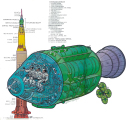 |  | 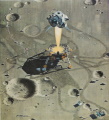 |
| Apollo 8 CSM & Saturn V diagram, from “Apollo 8: A Most Fantastic Voyage”, Vol. 135, No. 5, May 1969 | Apollo 11 LM “Eagle” flies over Little West crater during final approach to landing. From “The Flight of Apollo 11: “One Giant Leap For Mankind””, Vol. 136, No. 6, December, 1969 | Ascent Stage of Apollo 11 LM “Eagle” lifts off from Tranquility Base on the first leg of it’s voyage home. This is one of my all time favorites, because the artist, Pierre Mion, studied the TV downlink and the photos taken by the crew to accurately show the traverse routes and most of the equipment left behind. From “The Flight of Apollo 11: “One Giant Leap For Mankind””, Vol. 136, No. 6, December, 1969 |
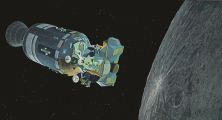 |  |  | 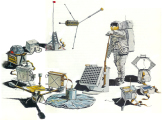 |
| Apollo 11 CSM “Columbia” and LM “Eagle” ascent stage docked in lunar orbit. The cutaway shows CMP Mike Collins in the tunnel, shaking hands with one of the LM crew. From “The Flight of Apollo 11: “One Giant Leap For Mankind””, Vol. 136, No. 6, December, 1969 | Another one of my all time favorites, this illustration shows each landing site as a cross section showing what the scientists thought were the substructures beneath the surface. From “How We Solved the Mysteries of the Moon”, Vol. 144, No. 3, September, 1973. This was the final issue of Nat Geo written about the Apollo program. | Apollo 15 LMP Jim Irwin against a dramatic backdrop of the moon, as seen by the CMP Al Worden during his trans-earth EVA to retrieve SIM Bay data canisters. From “Apollo 15 Explores the Mountains of the Moon”, Vol. 141, No. 2, February, 1972. | Major components of the Apollo Lunar Surface Experiments Packages (ALSEPs) left behind on the moon by the Apollo crews. From “How We Solved the Mysteries of the Moon”, Vol. 144, No. 3, September, 1973. |
Other illustrations, from different sources
 | 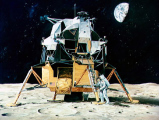 | 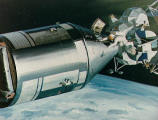 |  | 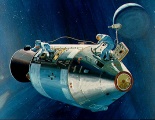 |
| Norman Rockwell painting of Apollo 11 first step on to the moon. This illustration was based on an early NASA photo of an astronaut rehearsing a moon walk. Click here to see the NASA photo. | Grumman artist’s depiction of Apollo 11 first steop on to the moon. Compare to image at left. | NASA artist’s depiction of Apollo 9 EVA by LMP Rusty Schweikhart. The original plan to have him transfer from the LM to the CSM, as shown, was aborted when he developed motion sickness early in the mission. | Cutaway illustration of the Apollo A7-L Extravehicular Mobility Unit (lunar space suit). I like this one so much I use it on my web page on the subject! | A really beautiful NASA illustration of the trans-earth EVA performed on the J-Series Apollo missions (15, 16, & 17) to retrieve the data canisters from the CSM SIM Bay. |
